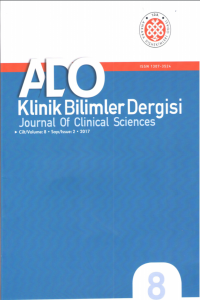Maksillofasiyal Protezlerin Yapımında Kullanılan Materyallerdeki Gelişmeler
Maksillofasiyal protetikmateryaller, silikon elastomerler
Improvements of Materials Used in Maxillofacial Prostheses
___
- Chalian VA, Phillips RW. Materials in maxillofacial pros- thetics. J Biomed Mater Res 5:349-363, 1974.
- Cerullo L, McKinstry RE. Ocular Prostheses: McKinstry RE. Fundamentals of facial prosthetics. Arlington; ABI Professional Pub, 1995, 100-104.
- Andres CJ, Haug SP, Brown DT, Bernal G. Effects of envi- ronmental factors on maxillofacial elastomers. Part II. Report of survey. J Prosthet Dent 68:519-522, 1992.
- Polyzois GL. Mechanical properties of 2 new addition –vul- canizing silicone prosthetic elastomers. Int J Prosthodont 12:359-362, 1999.
- Adisman IK, Minsley GE. Maxillofacial prosthetics. Öwall B, Käyser AF, Carlsson GE. Principles and management strategies. London: Mosby-Wolfe, 1996, 216-217.
- Lewis DH, Castleberry DJ. An assessment of recent advan- ces in external maxillofacial materials. J Prosthet Dent 43:426-432, 1980.
- Lontz JF. State-of-the-art materials used for maxillofacial prosthetic reconstruction. Dent Clin North Am 34:307- 325, 1990.
- Polyzois GL, Tarantili PA, Frangou MJ, Andreopoulos AG. Physical properties of a silicone prosthetic elastomer stored in simulated skin secretions. J Prosthet Dent 83:572-577, 2000.
- Kiat-Amnuay S, Gettleman L, Goldsmith LJ. Effect of multi- adhesive layering on retention of extraoral maxillofacial silicone prosthesis in vivo. J Prosthet Dent 92:294-298, 2004.
- Andres CJ, Haug SP, Munoz CA, Guillermo Bernal. Effects of environmental factors on maxillofacial elastomers: Part I-literature review. J Prosthet Dent 68:327-30, 1992.
- Hulterström AK, Ruyter E. Changes in appearance of sili- cone elastomers for maxillofacial Prostheses as a result of aging. Int J Prosthodont 12:498-504, 1999.
- Bulad K, Taylor RL, Verran J, McCord JF. Colonization and penetration of denture soft lining materials by Candida albicans. Dent Materials 20:167-175, 2004.
- Mohite UH, Sandrik LJ, Land MF, Byrne G. Environmental factors affecting mechanical properties of facial prosthetic elastomers. Int J Prosthodont 7:479-486, 1994.
- Haug SP, Moore KB, Andres CJ. Color stability and color- ant effect on maxillofacial elastomers. Part II: Weathering effect on physical properties. J Prosthet Dent 81:423-30, 1999.
- Tran NH, Scarbecz M, Gary JJ. In vitro evaluation of color change in maxillofacial elastomer through the use of an ultraviolet light absorber and a hindered amine light stabil- izer. J Prosthet Dent 91:483-90,2004.
- Kiat-amnuay S, Mekayarajjananonth T, Powers JM, Chambers MS, Lemon JC. Interactions of pigments and opacifiers on color stability of MDX4-4210/ type A max- illofacial elastomers subjected to artificial aging. J Prosthet Dent 95:249-57, 2006.
- Hanson MD, Shıpman B, Blomfield JV, Janus CE. Commercial cosmetics and their role in the coloring of facial prosthesis. J Prosthet Dent 50:818-20, 1983.
- Beatty MW, Mahanna GK, Jia W. Ultraviolet radiation- induced color shifts occurring in oil-pigmented maxillofa- cial elastomers. J Prosthet Dent 82:441-46, 1999.
- Polyzois GL. Color stability of facial silicone prosthetic pol- ymers after outdoor weathering. J Prosthet Dent 82:447- 50, 1999.
- Gary JJ, Huget EF, Powell DL. Accelerated color change in a maxillofacial elastomer with and without pigmentation. J Prosthet Dent 85:614-20, 2001.
- Aziz T, Walters M, Jagger R. Analysis of the properties of silicone rubber maxillofacial prosthetic materials. J Dent 31:67-74, 2003.
- Wolfaardt JF, Cleaton-Jones P, Lownie J, Ackermann G. Biocompatibility testing of a maxillofacial prosthetic elas- tomer: Soft tissue study in primates. J Prosthet Dent 68:331-38, 1992.
- Polyzois GL, Frangou MJ. Bonding of silicone prosthetic elastomers to three different denture resins. Int J Prosthodont 15:535-538, 2002.
- Kiat-amnuay S, Gettleman L, Khan Z, Goldsmith J. Effect of adhesive retention of maxillofacial prostheses. Part 2: Time and reapplication effect. J Prosthet Dent 85:438-41, 2001.
- Göre E, Evlioğlu G, Yaylalı Dİ, Çağlayan R, Azak AN. Üç farklı silicon elastomerinde Candida albicans tutunumunun karflılafltırılması. İstanbul Üniversitesi Difl Hekimliği Fakültesi Dergisi 39:31-35, 2005.
- ISSN: 1307-3540
- Yayın Aralığı: Yılda 3 Sayı
- Başlangıç: 2006
- Yayıncı: Ankara Diş Hekimleri Odası
Avulse Üst Daimi Keser Dişin Tedavisi: Multidisipliner Bir Yaklaşım
Kıvanç YAMANEL, Kamran GÜLŞAHI, Alper ÇALAR, Ömür POLAT
Karbon Dioksit Lazerin Ağız Dokularında Kullanımı
Piezoelektrik Cerrahinin Temelleri: Oral ve Maksillofasiyal Cerrahide Kullanımı
Bifosfonat Kullanımına Bağlı Gelişen Mandibula ve Maksilla Nekrozları ve Dental Yaklaşım
Diş Üniti Su Yolu ve Suyu Dental Tedavilerde Risk Oluşturur Mu?
Ortodontik Tedavide Alt Keser Çekimi
Ömür Polat ÖZSOY, Esen AYDOĞDU
Çocuklarda Dental İmplant Uygulamaları
Yeni Bir Bakış Açısı: Kanıt-Destekli Dişhekimliği
Ç Türksel DÜLGERGİL, Ertuğrul ERCAN, Işıl YILDIRIM, Meryem ERCAN, Murat ÖZTÜRK, Mehmet DALLI, Rojan ARCAK
Maksillofasiyal Protezlerin Yapımında Kullanılan Materyallerdeki Gelişmeler
